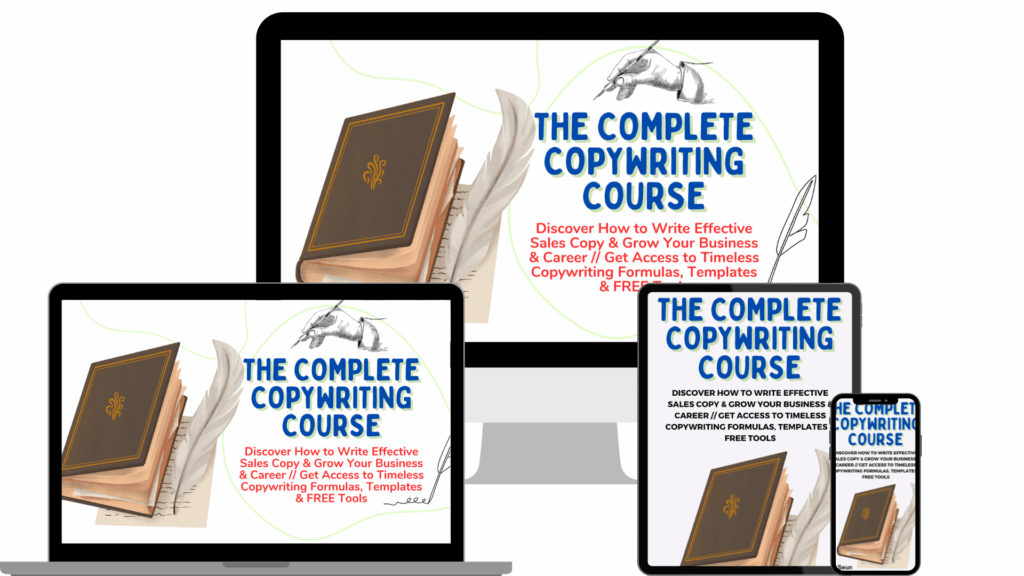Ever felt like you had a brilliant idea, a fantastic product, or a compelling story to tell, but when it came to putting it into words, everything just… fizzled? You’d stare at a blank page, the cursor blinking accusingly, and your message would get lost somewhere between your brain and your fingertips. That was me, for a very long time.
I remember those days vividly. I was trying to grow a small online venture, and I knew I needed to connect with people. I’d write product descriptions that sounded like instruction manuals, emails that felt stiff and formal, and social media posts that were, frankly, forgettable. My words lacked punch, they lacked heart, and most importantly, they lacked the power to move anyone to action. I felt like I was whispering into a hurricane, and my message was simply getting swept away.
Then, a little light bulb flickered on. I kept hearing this word – copywriting. At first, it sounded like some highly technical, intimidating jargon. Was it just about selling things? Was it some secret language only marketing gurus understood? I was intrigued, but also a little apprehensive. Could I actually learn to write copy that resonated?
My Journey to Discovering Copywriting: The "Aha!" Moment
The turning point wasn’t a sudden epiphany, but rather a slow realization that good communication wasn’t just about grammar; it was about psychology, empathy, and a dash of persuasive magic. I started observing the brands I loved, the emails I actually opened, and the ads that made me pause. What did they have in common? They spoke to me. They understood my problems, my desires, my aspirations. Their words weren’t just informative; they were inviting, engaging, and often, inspiring.
This wasn’t accidental. This was copywriting.
The more I delved, the more I understood that copywriting wasn’t just about tricking people into buying things. It was about clarity, connection, and building trust. It was about taking a complex idea and making it simple, compelling, and utterly irresistible. It was about turning a casual browser into an engaged reader, and eventually, a loyal customer. And suddenly, it didn’t feel so intimidating. It felt like a superpower I desperately wanted to unlock.
Why I Decided to Take the Plunge: Choosing My Copywriting Course
The internet is a vast ocean of information, and when I started looking for ways to learn copywriting, I found everything from free blogs to high-ticket masterminds. It was overwhelming. I knew I needed structure, guidance, and practical exercises, not just theory. I wanted a roadmap, not just a pile of ingredients.
After sifting through countless options, reading reviews, and even watching a few introductory videos, I finally settled on a "Copywriting Course for Beginners." What drew me in? It wasn’t the flashiest, but the instructor’s approach felt genuine and grounded. They emphasized understanding the why behind the words, not just memorizing formulas. They promised practical assignments, real-world examples, and a community where I could get feedback. That last part was crucial – I didn’t want to learn in a vacuum.
I still remember the mix of excitement and nerves as I clicked "enroll." It felt like a significant investment, not just of money, but of my time and my belief in myself. Could this really be the key to transforming my messages from muddled to magnetic?
What I Actually Learned: The Heart of the Copywriting Course
Stepping into that online course was like stepping into a secret garden of words. It wasn’t just about learning rules; it was about understanding the art and science of communication. Here’s a glimpse into the treasure trove of insights I uncovered:
Beyond Just Words: Understanding Your Audience
This was probably the biggest eye-opener. Before the course, I wrote for myself, or a vague, generic "everyone." The course drilled into me the importance of creating an "avatar" – a detailed profile of my ideal reader. What are their hopes? Their fears? Their daily struggles? What language do they use? This shifted my perspective entirely. Instead of trying to tell people something, I started learning how to speak directly to them, addressing their specific pain points and aspirations. It felt less like selling and more like a conversation.
The Power of Storytelling and Emotion
Humans are wired for stories, and this course taught me how to weave narratives into my copy. Whether it was a short anecdote in an email or a compelling case study on a sales page, stories made my words come alive. I learned how to tap into emotions – joy, relief, curiosity, even a touch of FOMO (Fear Of Missing Out) – to create a deeper connection. It wasn’t about being manipulative; it was about being relatable and human.
Crafting Irresistible Headlines and CTAs (Calls to Action)
Oh, the headlines! Before, I’d just slap a title on things. Now, I understood headlines were the gatekeepers. They had to grab attention, promise a benefit, and make people want to read more. We dissected countless examples, practiced writing dozens, and learned techniques to make them pop.
And the Call to Action (CTA)? This was where my old copy truly failed. My CTAs were weak, vague, or non-existent. The course taught me how to craft clear, compelling calls that left no doubt about what the reader should do next, and more importantly, why they should do it. "Learn More" became "Unlock Your Creative Potential Today!" – a small change with a huge impact.
The Art of Editing and Refining
This was tough love, but essential. My initial drafts were often messy, wordy, and sometimes, still a little self-indulgent. The course emphasized ruthless editing. Cut the fluff. Be concise. Read it aloud. Get feedback. I learned that good copy isn’t written; it’s rewritten. This practice, though sometimes painful, sharpened my writing immensely.
Practical Application and Feedback
This was the backbone of the course. Each module came with exercises, from analyzing existing copy to writing my own from scratch. The real magic happened when I submitted my work and received constructive feedback from the instructor and fellow students. It was invaluable to see how others interpreted my words and to learn from their perspectives. It solidified the lessons and gave me the confidence to apply them in the real world.
The Transformation: Life After the Copywriting Course
Emerging from that course felt like stepping out into a brand new world, armed with a powerful new lens through which to see communication. The shift wasn’t just in my writing; it was in my mindset.
- Confidence Soared: No longer did I dread writing. I approached it with a sense of purpose and a toolbox full of techniques. The blank page no longer felt like an adversary, but an exciting opportunity.
- My Messages Resonated: My emails started getting opened. My product descriptions weren’t just informative; they were persuasive. My social media posts garnered more engagement. People started understanding what I was trying to say, and more importantly, they started responding.
- New Opportunities Unlocked: Suddenly, I wasn’t just writing for my own small venture. Friends and colleagues started asking for help with their writing. I even started taking on small freelance projects, which was something I never thought possible. The course didn’t just teach me a skill; it opened doors to new avenues.
- A Deeper Understanding of Marketing: Copywriting isn’t just a standalone skill; it’s the heart of all marketing. Understanding how to craft compelling words gave me a holistic view of how businesses connect with their audience.
Is a Copywriting Course Right for You? (My Honest Take)
If you’re reading this and nodding along, feeling that familiar pang of frustration with your own words, then my answer is a resounding YES. A well-structured copywriting course can be a game-changer, especially for beginners.
Who is it for?
- Entrepreneurs and Small Business Owners: If you’re wearing multiple hats, learning to write your own compelling marketing materials is invaluable.
- Content Creators & Bloggers: Want your articles and posts to not just inform, but also inspire and convert? This is for you.
- Aspiring Freelance Writers: It’s the foundational skill you need to build a successful career.
- Anyone Who Wants to Communicate More Effectively: From job applications to personal branding, persuasive writing skills are universally beneficial.
What to Look For in a Good Course:
- Experienced Instructor: Someone who doesn’t just teach theory but has real-world experience.
- Practical Exercises: Theory is good, but application is crucial. Look for courses with assignments and projects.
- Feedback Opportunities: This is where you truly grow. Whether it’s peer feedback or instructor critiques, it’s essential.
- Clear, Beginner-Friendly Curriculum: Avoid courses that jump straight into jargon. Start with the fundamentals.
- Community: Learning alongside others can be incredibly motivating and provide diverse perspectives.
- Value for Money: It doesn’t have to be the most expensive course, but consider the investment in your skills.
Final Thoughts: Your Words, Amplified
Taking that copywriting course wasn’t just about learning a new skill; it was about finding my voice. It taught me that every word has a purpose, every sentence an intention. It transformed my ability to connect, persuade, and truly be heard.
If you’re on the fence, I encourage you to take that leap. Invest in your words. Invest in your ability to communicate clearly, powerfully, and with genuine impact. Because when you learn the art of copywriting, you’re not just writing better sentences – you’re amplifying your message, your passion, and your potential to reach the people who truly need to hear what you have to say. And that, my friends, is a truly remarkable superpower.



